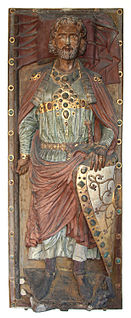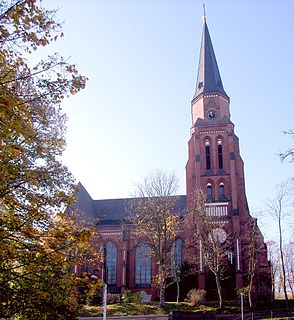Life
Along with the Přemyslid Kings of Bohemia Bruno was one of the most active participants in the German settlement of Upper Lusatia. For one thing, this was the location of the majority of the estates of the bishops of Meissen; for another, Bruno was keen in this way to secure his power in Upper Lusatia against the inroads of the Bohemians.
In 1228 he was removed from his office by Pope Gregory IX, presumably because of his reckless behaviour, and died on 4 December in the same year. His body was buried in the crypt of the collegiate church in Bautzen, which he had founded himself between 1213 and 1218.
In 1225 Bruno dedicated the Chapel of St. George in the Matthias Gate [2] in Ortenburg, Bautzen.

Lusatia, also known as Sorbia, is a historical region in Central Europe, split between Germany and Poland. The region is the home of the ethnic group of Sorbs. It stretches from the Bóbr and Kwisa rivers in the east to the Pulsnitz and Black Elster in the west, today located within the German states of Saxony and Brandenburg as well as in the Lower Silesian and Lubusz voivodeships of western Poland.
The Peace of Bautzen was a treaty concluded on January 30, 1018, between the Ottonian Holy Roman Emperor Henry II and the Piast duke of the Polans Bolesław I Chrobry which ended a series of Polish-German wars over the control of Lusatia and Upper Lusatia as well as Bohemia, Moravia and Slovakia.

Bischofswerda is a small town in Germany at the western edge of Upper Lusatia in Saxony.

The Bishop of Dresden-Meissen is the ordinary of the Roman Catholic Diocese of Dresden-Meissen in the Archdiocese of Berlin.

Upper Lusatia is a historical region in Germany and Poland. Along with Lower Lusatia to the north, it makes up the region of Lusatia, named after the Slavic Lusici tribe. Both Lusatias are home to the West Slavic minority group of the Sorbs.

Hochkirch is a municipality in the district of Bautzen, in Saxony, Germany. It is known for the 1758 Battle of Hochkirch, part of the Seven Years' War.

The Diocese of Dresden-Meissen is a Diocese of Catholic Church in Germany with its seat in Dresden. It is suffragan to the Archdiocese of Berlin.

The Wesenitz is a river in Saxony, Germany, right tributary of the Elbe. Its total length is 83 km (52 mi). The Wesenitz runs through the tourist regions of the Lusatian Highlands and Saxon Switzerland. Its name is derived from Sorbian language wjaz (Elm).

The Milceni or Milzeni were a West Slavic tribe, who settled in the present-day Upper Lusatia region. They were first mentioned in the middle of the 9th century AD by the Bavarian Geographer, who wrote of 30 civitates which possibly had fortifications. They were gradually conquered by Germans during the 10th century. Modern descendants of the Milceni are the Sorbs of the Free State of Saxony, Germany.

Conrad I, called the Great, a member of the House of Wettin, was Margrave of Meissen from 1123 and Margrave of Lusatia from 1136 until his retirement in 1156. Initially a Saxon count, he became the ruler over large Imperial estates in the Eastern March and progenitor of the Saxon electors and kings.

The March or Margraviate of Lusatia was as an eastern border march of the Holy Roman Empire in the lands settled by Polabian Slavs. It arose in 965 in the course of the partition of the vast Marca Geronis. Ruled by several Saxon margravial dynasties, among them the House of Wettin, the lordship was contested by the Polish kings as well as by the Ascanian margraves of Brandenburg. The remaining territory was finally incorporated into the Lands of the Bohemian Crown in 1367.

Wiprechtof Groitzsch was the Margrave of Meissen and the Saxon Ostmark from 1123 until his death. He was born to a noble family of the Altmark, the son of Wiprecht of Balsamgau and Sigena of Leinungen. After his father's death in 1060, he was raised at the court of Lothair Udo II, Margrave of the Nordmark, in Stade.

The Diocese of Görlitz is a diocese of the Roman Catholic church in Germany. The current ordinary is Wolfgang Ipolt
Theodoric II was Margrave of Lusatia from 1032 to 1034, the first of the Wettin dynasty.

St. Peter's Cathedral is an interdenominational church in Bautzen, Germany. It is among the oldest and largest simultaneum churches in Germany. Located in the heart of the city's "Old Town", the church and the square it is situated within is a major tourist attraction.

Gaussig House is a manor house in Palladian style located in the district Bautzen in the German state of Saxony approximately 6 km southwest from the Upper Lusatian central city Bautzen. Extending over some 75 acres (300,000 m2), nestled in beautiful natural surroundings and bordered by the Grosse Picho hill to the south, lies one of Upper Lusatia’s largest landscape parks. Gaussig House, the orangery, the church and vicarage, and the estate form the centre of Gaussig village.
The German–Polish War which took place from 1002 to 1018 consisted of a series of struggles between the Ottonian king Henry II of Germany and the Polish Piast ruler Bolesław I the Brave. The locus of conflict was the control of Lusatia, Upper Lusatia, as well as Bohemia, Moravia and Slovakia. The fighting ended with the Peace of Bautzen in 1018, which left Lusatia and Upper Lusatia as a fief to Poland, and Bohemia became a duchy in the Holy Roman Empire.
Heinrich of Meissen was Bishop of Meissen from December 1228 to his death.
Withego von Furra or de Wuor, otherwise Withego I of Meissen or Withego I von Furra was Bishop of Meissen from 1266 to his death.

Johannes Leisentritt, also Johann Leisentrit was a Catholic priest, dean in St. Peter in Bautzen and administrator of the Diocese of Meißen, responsible for Lusatia. He is known for publishing a 1567 hymnal.














